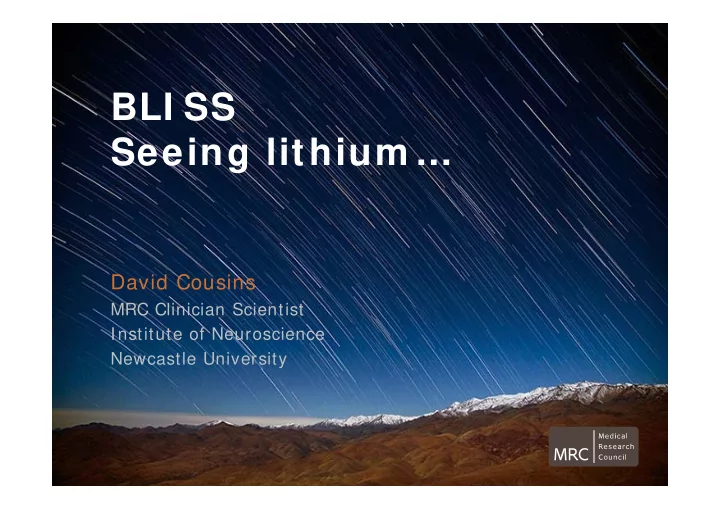

BLI SS Seeing lithium … David Cousins MRC Clinician Scientist Institute of Neuroscience Newcastle University
Bipolar Disorder 1 in 100 people Highly recurrent Response Suicidality 30% Stratification target Lithium Unique profile Proven efficacy Toxicity BLISS
CROSS SECTI ONAL DESI GN Euthym ic BD Anatomy Relaxometry Maintenance HC 40 I nnovative analysis Matched groups BD BD Range of response Cognitive MS 40 Li 80 testing 1 H MRS RESPONSE TO LI THI UM Defining response WMHI DTI ConLiGen Rating response Alda • Reliability Quantitative • Validity Lithium BLI SS • Suitability MRS
BLISS CPT reaction time
BLISS D2 item processing
BLISS Cortical Thickness
BLISS Cortical Thickness Lithium group > bipolar control group Left hemisphere Right hemisphere
BLISS Diffusion Tensor Imaging Fractional anisotropy is held to be lowered in BD Lithium has the potential to normalise FA DTI WMHI
BLISS Diffusion Tensor Imaging
BLISS 1 H MRS frontal WM voxel
128 MHz
Soares 2000 49.6 MHz
49.6 MHz T 1 W 7 Li ‐ MRI
Phantom insights Cousins DA, PhD Thesis 2011
Phantom insights Steady ‐ state free precession Incomplete dephasing T2 adds to T1 signal MR Sequence: FISP or b ‐ SSFP Cousins DA, PhD Thesis 2011
Direct molecular Li imaging Lithium distribution in the human brain Euthymic bipolar disorder (n=8) group average in standard space bSSFP sequence 8 minutes duration at 3T MOLECULAR PSYCHIATRY in press
Direct molecular Li imaging Lithium distribution in the human brain Euthymic bipolar disorder single subject bSSFP sequence 8 minutes duration at 3T MOLECULAR PSYCHIATRY in press
Direct molecular Li imaging Lithium distribution in the human brain Euthymic bipolar disorder (n=8) individual distributions in native space bSSFP sequence 8 minutes duration at 3T MOLECULAR PSYCHIATRY in press
7 Li-MRI test objects MOLECULAR PSYCHIATRY in press
WP5 Partners France Paris 3T GE/7T Siemens Frank Bellivier & Cynthia Marie ‐ Claire INSERM ‐ UMR S1144 Emmanuel Haffen France Besancon 3T Siemens Université de Franche ‐ Comté (emmanuel.haffen@univ ‐ fcomte.fr) Institute of Neuroscience – Newcastle UK Newcastle 3T Philips David Cousins & Jan Scott University King's Health Economics, King's College UK London Allan Young & Paul McCrone 3T GE London Department of Clinical Psychology and Germany Mainz Michelle Wessa 3T Siemens Neuropsychology Mainz University Germany Dresden Michael Bauer 3T Siemens University Hospital Carl Gustav Carus 3T Philips / Germany Munich (Siemens: starting Thomas Schulze LMU München 2018) Fatebenefratelli Institute Brescia IRCCS Italy Brescia Annamaria Cattaneo Laboratory of Biological Psychiatry 3T Philips Italy Milano Paolo Brambilla & Letizia Squarcina IRCCS Ca' Granda Policlinico di Milano (?system change) Psychiatric Center Copenhagen, Denmark Lars Kessing 3T Siemens Copenhagen Rigshospitalet Sweden 3T GE Gothenburg Mikael Landén University of Gothenburg Norway Oslo 3T GE Ole Andreassen Oslo University Hospital Hospital Clinic, University of Barcelona, Spain Barcelona Eduard Vieta & Jose M GOIKOLEA 3T Siemens IDIBAPS, CIBERSAM Institut Hospital del Mar d'Investigacions Spain Barcelona Frances Colom 3T Philips Mèdiques Poland Poznan Aleksandra Suwalska 3T Siemens Poznan University of Medical Sciences
BLISS recruitment Cognitive estimates • Newcastle central population 300K • Bipolar disorder 1% • Potential cases 3K • Proportion on lithium 10% • Should be 300 identifiable patients
BLISS Single laboratory approach BIOCHEMISTRY REPORT 2015 ‐ 16 3258 Individual lithium tests 320 working age adult patients 1486 tests excluded (age >63 or no taking lithium patient identifier)
BLISS Single laboratory approach BIOCHEMISTRY REPORT 2015 ‐ 16 3258 Individual lithium tests 320 working age adult patients 1486 tests excluded (age >63 or no taking lithium patient identifier) BIOCHEMISTRY REPORT 2016 ‐ 17 119 patients known to be on 182 patients continue to have lithium >1 year and with a care lithium levels checked coordinator Identified 55 new cases in which 65 patients confirmed to have lithium was started and monitored ceased taking lithium
Recommend
More recommend